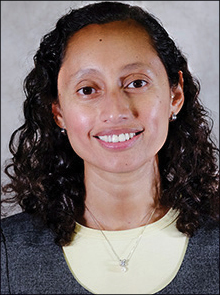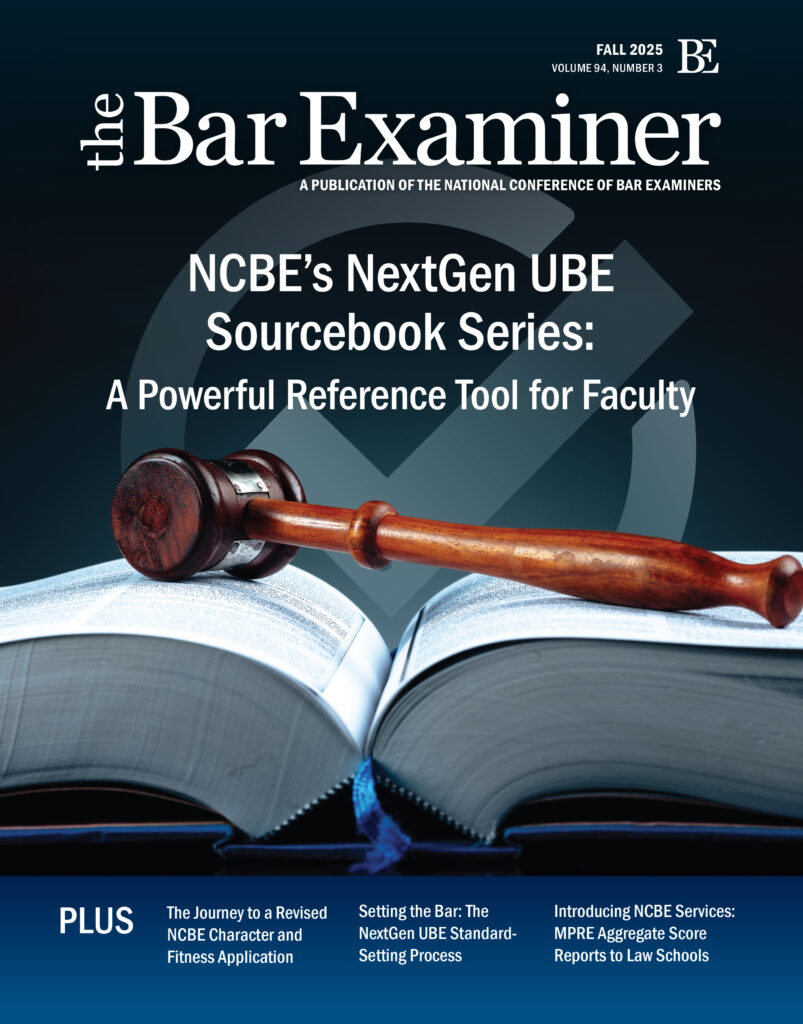This article originally appeared in The Bar Examiner print edition, Spring 2021 (Vol. 90, No. 1), pp. 69–72.By Cassandra Sneed Ogden and Lynda Cevallos, Esq.
A series of articles on topics of immediate significance to the bar admissions community.
DIVERSITY SERIES: Diversity in the legal profession and efforts to enhance the participation and success of underrepresented and/or historically disadvantaged groups in legal education and bar admissions.
When Council on Legal Education Opportunity Inc. (CLEO) students are asked why they want to become lawyers, they often express their desire to improve the quality of life for folks living in America, especially those within their communities. Many CLEO students are first-generation college graduates pursuing their dream of becoming a lawyer to right some of the wrongs they observed growing up. But it can be challenging for them to overcome the obstacles they see in front of them in order to achieve their goals. Becoming a member of the legal profession is not an easy task, and can be formidable if a student does not believe that he/she “belongs” there.1 For economically disadvantaged first-generation college graduates, or those who were not reared in English-speaking households, the path to the legal profession can be even more daunting.
A Brief History of CLEO and Minority Representation in Law School and the Legal Profession
The seeds of CLEO were first planted in the mid-1960s when the Civil Rights Act of 1964 drew attention to the fact that minorities represented only 3% of the nation’s lawyers. A few years later in 1967, the then dean of Emory University, Ben F. Johnson, Jr., and law professor Nathaniel Gozansky partnered with Morehouse College History Department chair Melvin Kennedy to introduce Pre-Start, a summer program to admit graduates to Emory University Law School. Based on the early positive feedback from Pre-Start, the American Bar Association, the Association of American Law Schools, the Law School Admission Council, and the National Bar Association joined forces to create CLEO.
With funding from the Ford Foundation and the US Office of Economic Opportunity, the inaugural CLEO pre-law institutes for entering 1Ls were held in the summer of 1968 at four law schools: the University of Denver, Emory University, Harvard, and UCLA. In 1969, Harvard Law School’s Frank E.A. Sander spearheaded the effort for CLEO to develop partnerships with “clusters” of law schools, which led to CLEO’s sponsoring 11 pre-law institutes that summer. Since those first two years, CLEO has hosted close to 100 institutes with approximately 5,000 attendees.
Historically speaking, according to US Census Bureau data, there were 4,000 black lawyers in 1970, almost 16,000 in 1980, about 25,000 in 1990, and close to 45,000 as recently as 2005.2 And while these figures definitely represent an upward-trending trajectory, when you take into account a total attorney population of 1.1 million, even the 2005 figure equates to only 4% of the entire pool. And 15 years later, where are we? As of 2020, the ABA reports that 5% of US lawyers are black, a meager 1% increase. Further, just 5% are Hispanic and 2% are Asian.3 In the professions of medicine and accounting, although black representation has not risen above 10% in either field, it is at least a little better than in the legal profession.
With respect to law students, for much of the early- to mid-1900s, blacks and other minorities weren’t even permitted to enroll at many ABA-accredited law schools. And while this practice of overt discrimination was no longer in widespread use as of the 1960s when CLEO came into existence, the percentages of black law students have come nowhere close to mirroring the demographic trends in many undergraduate student populations. In the 1970s, about 2.5% of law students were black. Fast-forward to the 2000s, and this number rose to 6.75%, and for the past decade, almost 8% of law students were black,4 which only slightly outpaces black representation in the profession itself. The statistical representation over this same time period for other ethnicities, including Hispanics and Asian Americans, is, unfortunately, just as meager.
Consequently, when CLEO was founded in 1968, its charge to increase the number of black and low-income students in law school was critical. CLEO worked to identify talented students who had graduated from historically black colleges and universities (HBCUs) and enroll them in a rigorous, boot-camp-like prelaw summer program that prepared them to be admitted to and succeed at traditional (non-HBCU) law schools.
CLEO’s Prelaw Programs
Today, the prelaw summer program is still CLEO’s flagship offering. Over the last 52 years, CLEO has continuously sponsored the Prelaw Summer Institute (PLSI)—a six-week residential program (now conducted virtually), co-sponsored by one of our law school partners in the CLEO Consortium on Diversity in Legal Education, that gives students an opportunity to demonstrate their likelihood of success in law school. (In 2020, when the coronavirus mandated the closing of most on-campus educational institutions, the PLSI, hosted by Penn State Dickinson Law, was successfully conducted totally online. It will continue to be conducted online in 2021 and most likely beyond.) Participants undergo rigorous training, which simulates the first year of law school. Taught by law professors, students learn how to brief cases, how the US judicial system works, the IRAC method of dissecting an exam,5 and more.
The CLEO Consortium on Diversity in Legal Education is a group of law schools that supports CLEO in its efforts to diversify the legal profession. Penn State Dickinson Law has been a partner law school of the consortium for more than six years. Unlike other prelaw summer programs, which rely heavily on student GPA and LSAT score, CLEO takes a more holistic approach in selecting students to participate in the PLSI.
CLEO also sponsors the 1L Prep—Attitude Is Essential online weekend program, which provides admitted law students with an orientation to the Socratic method of teaching and other essential information.
These programs have helped hundreds of prelaw students who, given the opportunity and the necessary support, were able to turn their dreams into reality and successfully graduate from law school with just one last mountain to climb: the bar exam. But unfortunately, many students had neither adequate equipment nor an experienced guide when it came to this final challenge. Although many law schools now offer for-credit bar preparation classes to their third-year students, these classes are generally not required. Consequently, those who might benefit the most from such classes often fail to take advantage of them. And while many commercial bar prep programs offer discounts to students who sign up during their first year, many CLEO students are not in a financial position to take advantage of this option or, worse, don’t comprehend its importance.
The NCBE/CLEO Bar Passage Program
In 2018, CLEO received a grant from the National Conference of Bar Examiners to help our law students prepare to pass the bar examination. This was the beginning of an exciting partnership that has enabled CLEO to begin addressing many of the issues confronted by our students as they face this final challenge, empowering CLEO to design a bar program to help students know that they belong in the community of lawyers.
The NCBE/CLEO Bar Passage Program exposes students to components of the bar exam before their first day of law school, encourages them to remain mindful of the exam’s importance throughout their three-year legal education, and helps them prepare to pass the exam. The program includes
- expanded programming, such as webinars with Q&A segments, to familiarize 2Ls, 3Ls, and graduates with the bar examination and prepare them to pass it;
- a new bar exam orientation for students in the summer programs;
- weekly sample MBE questions supplied by NCBE, sent out to students via email;
- MEE and MPT essay review, whereby students have the opportunity to submit essays that are reviewed by law professors who serve as CLEO bar prep consultants;
- quarterly webinars on topics such as how to prepare for the MPT, the UBE, and the MPRE, including time management skills;
- commercial bar prep program scholarships; and
- mentoring support for students preparing to sit for the examination.
The mentoring support program is modeled after the highly effective program at Florida International University College of Law, and we have been especially pleased with the support the program has received. In addition to the numerous CLEO alumni and friends who have volunteered to serve as mentors, the program has attracted high-profile lawyers of color, including former ABA president Paulette Brown and retired Georgetown dean of students Everett Bellamy.
The first cohort of students to benefit from the NCBE partnership sat for the July 2019 bar examination. CLEO’s partnership with NCBE is helping CLEO to build a better community: a community of belonging in the legal profession, especially for 2Ls, 3Ls, and recent graduates.
Training Tomorrow’s Lawyers, Preparing Tomorrow’s Leaders
Since CLEO’s inception, more than 25,000 individuals have benefited from one or more CLEO programs and/or utilized a service. Of this number, over 8,000 have matriculated to law school and gone on to excel in every area of the legal profession; they include judges, in-house counsel, firm practitioners, law school deans and professors, politicians, executives of nongovernmental organizations, business leaders, and more.
Over the years, CLEO has received numerous testimonials from previous program participants regarding the impact that CLEO had in solidifying their successful path to the legal profession. Baltimore City State’s Attorney Marilyn Mosby, Senior US District Judge Reggie Walton, and US Congresswoman Nanette Diaz Barragán are three examples of CLEO alumni who have achieved noteworthy professional success, yet still make a concerted effort to stay connected with and lend their support to the organization.
During CLEO’s 50th anniversary in 2018, Representative Barragán stated, “As an alumna of CLEO, I know firsthand the difference CLEO makes to develop the necessary edge in law school that leads to success. It did that for me and so many other students.” We are proud of the contributions that all of our alumni have made to the legal profession and are genuinely excited about those that will be made by current and future CLEO participants!
Though we have made progress, there is more work to be done.
As the longest-serving nonprofit organization designed to inspire, motivate, and prepare students from underrepresented communities to succeed in law school and beyond, CLEO sincerely appreciates the support of NCBE to help us realize our vision: That the United States legal profession is truly diverse, equitable, and inclusive and that it effectively balances the scales of liberty and social justice for all. For more than 50 years, CLEO has remained committed to Training Tomorrow’s Lawyers, Preparing Tomorrow’s Leaders. The NCBE/CLEO partnership has enabled more CLEO students to achieve their dreams and strengthened CLEO’s efforts to help them in both becoming part of the legal profession and belonging to the cohort of great lawyers in whose footsteps they follow.
For additional information about CLEO, visit https://cleoinc.org/.
Notes
- In her dissertation, A Phenomenological Case Study: The Law School Environment as Experienced by Academically Dismissed Black and Latina/o Law Students, Erin C. Lain, PhD, JD, Associate Provost for Campus Equity and Inclusion, Associate Professor of Law at Drake University, and CLEO consultant, states that for students to reach their academic goals, they must experience “full membership in[] the community…and a sense of safety in belonging and engagement within their academic environment.” (Go back)
- Todd Steven Burroughs, PhD, “The Current State of Black Lawyers, In and Out of the Civil Rights Arena,” 9(1) Diversity & the Bar (January/February 2007), available at https://www.mcca.com/mcca-article/current-state-of-black-lawyers/. (Go back)
- American Bar Association, ABA Profile of the Legal Profession 2020, available at https://www.americanbar.org/content/dam/aba/administrative/news/2020/07/potlp2020.pdf. (Go back)
- “[A]lmost 8% of law students were black…”: Gabriel Kuris, “What Underrepresented Law School Applicants Should Know,” U.S. News & World Report, June 8, 2020, available at https://www.usnews.com/education/blogs/law-admissions-lowdown/articles/what-underrepresented-law-school-applicants-should-know. (Go back)
- IRAC stands for Issue, Rule, Analysis, Conclusion. The IRAC approach to answering exam questions has students go through the fact pattern, spot as many issues as they can, state the rules of law, apply the law to the facts, and arrive at conclusions. (Go back)
 Cassandra Sneed Ogden served as CLEO’s Chief Executive Officer from 1995 to 2020.
Cassandra Sneed Ogden served as CLEO’s Chief Executive Officer from 1995 to 2020.
 Lynda Cevallos, Esq., is the Director of Prelaw Educational Activities at CLEO.
Lynda Cevallos, Esq., is the Director of Prelaw Educational Activities at CLEO.
Contact us to request a pdf file of the original article as it appeared in the print edition.







